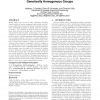Free Online Productivity Tools
i2Speak
i2Symbol
i2OCR
iTex2Img
iWeb2Print
iWeb2Shot
i2Type
iPdf2Split
iPdf2Merge
i2Bopomofo
i2Arabic
i2Style
i2Image
i2PDF
iLatex2Rtf
Sci2ools
GECCO
2010
Springer
2010
Springer
Evolution of division of labor in genetically homogenous groups
Within nature, the success of many organisms, including certain species of insects, mammals, slime molds, and bacteria, is attributed to their performance of division of labor, where individuals specialize on specific roles and cooperate to survive. The evolution of division of labor is challenging to study because of the slow pace of biological evolution and imperfect historical data. In this paper, we use digital evolution to evolve groups of clonal organisms that exhibit division of labor. We then investigate what mechanisms they use to perform division of labor (i.e., location awareness or communication) and discover that it varies according to the type of roles being performed. Lastly, we created an environment where groups of organisms needed to complete a set of tasks, but could do so as either generalists or specialists. We varied the costs of switching tasks and determined that increased costs can result in the evolution of division of labor. Moreover, a group used as a case...
| Added | 19 Jul 2010 |
| Updated | 19 Jul 2010 |
| Type | Conference |
| Year | 2010 |
| Where | GECCO |
| Authors | Heather Goldsby, David B. Knoester, Charles Ofria |
Comments (0)

